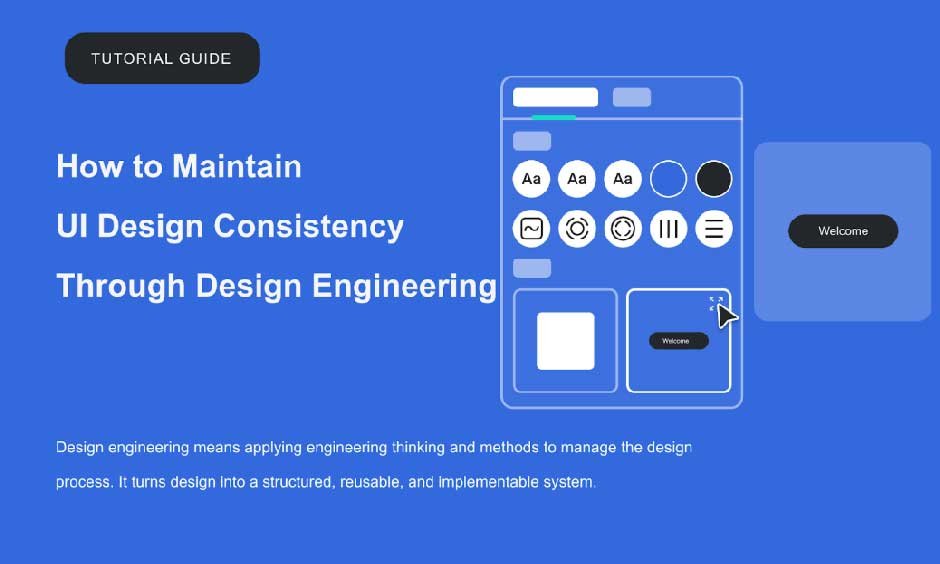Skip to the good bit
ToggleWhen building products, many teams run into the same annoying problems. After designers pass their work to developers, the final product doesn’t look like the original design. People end up spending more time talking to fix issues, and they have to redo work over and over.
Fixing these problems isn’t as simple as just having design rules or a development checklist. What teams really need is a step-by-step system that helps everyone work better together and make higher-quality stuff.
This article explains the basics of design engineering. It shows how using this approach helps designers and developers work together smoothly—all while keeping the look and feel of the product consistent, which is key for good UI design.
1. Why Design and Development Always Misalign?
A designer’s sleek mockup might look perfect on the canvas, but the final product often “drifts” from the original vision. This gap stems from several root causes:
- Lack of unified design standards: Without clear rules for colors, typography, or spacing, developers are left to interpret design intent, leading to inconsistent execution.
- Ambiguous component definitions: Designers may use ad-hoc graphic groups, while developers need structured, reusable components to translate into code.
- Ineffective handoff processes: Design files missing annotations or semantic details force developers to guess at specs, eroding consistency in UI design.
- Fragmented collaboration tools: When designers, product managers, and developers work in siloed tools, critical details get lost in translation.
- Unmanaged version changes: Frequent updates to designs make it hard to track which iteration should be implemented, causing rework.
These issues don’t just slow teams down. They derail product timelines and harm user experience. The solution? Design engineering.
By integrating design engineering practices, teams can bridge the design-to-dev gap, ensuring that what’s designed is what’s built. This not only streamlines collaboration but also lays the groundwork for lasting consistency in web design and beyond.
2. What Is Design Engineering?
Design engineering means applying engineering thinking and methods to manage the design process. It turns design into a structured, reusable, and implementable system. Its goal isn’t to turn designers into engineers. Instead, it uses standardization and automation to make design truly serve product development, so “design is delivery.”
Three core elements of UI design engineering:
- Design system: Unifies visual standards like colors, typography, and components. It builds team consensus, ensures consistency in UI design, and avoids unnecessary deviations.
- Component library collaboration: Designers and developers use the same UI component library. This ensures high consistency between design files and final implementation, reducing redundant work and errors. Each design component has a standardized definition, making it easy for developers to reuse and implement designs quickly.
- Automated handoff: A key part of design engineering. Tools convert design files into structured code, cutting down manual work and boosting delivery efficiency.
3. How Pixso Helps with Design Engineering?
Pixso is a tool that lets designers work together, and it’s great for these three key parts of design engineering. It gives teams the tools they need to use engineering methods in design, making it easier for everyone to work together well.
Design system and standardization
Pixso lets teams build a unified design system on the platform, including standard color palettes, typography, components, and layout rules. Plus, Pixso AI can auto-generate design systems. This helps teams quickly organize design guidelines, ensuring every design meets team standards—so both designers and developers work from the same playbook for consistency in web design.
UI component library management
Pixso offers features to build and manage component libraries. Designers and developers share this library, which updates in real time. Changes in design sync instantly with development, avoiding the traditional information gap between design and engineering. This keeps UI design consistency intact through the process.
One-click code generation and automated handoff
Pixso’s new D2C (Design to Code) feature is powerful. It automatically converts design files into structured front-end code (like HTML, ArkUI, Flutter). Developers no longer need to manually slice images or recreate styles—they get ready-to-use code, drastically speeding up handoff and ensuring consistency in UI design from start to finish.
4. How to Keep Design and Development Aligned?
Consistency in UI design and efficient collaboration between design and development teams can be achieved with Pixso. Here are key steps to use Pixso for keeping design and development in sync:
Step 1: Create a Unified Design System
A design system typically includes color styles, text styles, effect styles, stroke styles, corner radii, and spacing rules. Traditionally, crafting these required designers to manually analyze every element: time-consuming and complex. Now, Pixso AI streamlines this by generating design system guidelines with one click.
Input a theme: In Pixso AI’s design system panel, type the theme for your guidelines. Use the “Primary Color” button to adjust and set the main hue.
Choose generation mode: Pixso AI offers two options. First, generate a static document: the system inserts the guidelines as a document into your Pixso canvas, creating a new “Design System” page with artboards detailing every element—colors, fonts, spacing—and their rules, giving the team clear direction. Second, apply styles directly: the generated colors, text, and effect styles are added to your current design file, with corresponding styles created automatically.
Step 2: Build a Standardized Component Library
Pixso lets designers and developers co-create and maintain a design component library. Designers can standardize common UI elements (buttons, tags, charts, etc.) by defining their styles, sizes, and interactions. All components follow unified standards, preventing inconsistent visuals.
To build the library:
– Start by creating color, font, and effect style libraries in Pixso, following your design system. Open your design guidelines file, select a color swatch, and click “Styles” to save it as a color style—repeat for fonts and effects.
– Begin with basic components like buttons, icons, and data entry fields. For example, design a “Primary Button,” then use Pixso’s “Component Properties” panel to quickly generate variants. For components needing auto-layout, set parameters to ensure consistent spacing between elements.
Step 3: Export Ready-to-Use Frontend Code with One Click
Pixso’s built-in D2C (Design to Code) feature converts designs to code for frameworks like HTML, Flutter, and ArkUI in one click. Switch your design to developer mode, select the code format via D2C, and the system generates a complete code structure in seconds. This “design-as-delivery” approach cuts frontend workload and avoids style distortions from misinterpretation—key for maintaining consistency in web design.
Step 4: Real-Time Collaboration and Version Control
Pixso supports multi-user online editing, with synchronized access to designs and code. Designers and developers can collaborate on the same page. Set project permissions and use version control: every edit is logged, so developers can easily check the latest design or history versions. This ensures code aligns with the most up-to-date design, preventing errors from unsynced updates and safeguarding UI design consistency.
5. Tips for Implementing Design Engineering
UI design engineering isn’t just about following steps—it needs smart strategies to ensure success. Here are some tips to follow when use design engineering.
- Regularly maintain design systems and component libraries
Keep your design system and component libraries in sync with the latest needs. Update and maintain them regularly to preserve consistency in UI design and reusability, cutting down on unnecessary rework.
- Unify team toolchains
Choose design tools that fit your team’s collaboration needs, and make sure everyone uses the same toolchain. Platforms like Pixso, an all-in-one design collaboration solution, let teams handle design, collaboration, and code generation in one place. No tool-switching means simpler workflows and better overall team efficiency—key for maintaining consistency in web design.
- Set handoff standards
Define clear rules for naming design files, annotation requirements, and delivery formats. This ensures smooth handoffs between design and development, reducing communication errors and rework to keep projects on track.
6. Conclusion
Using design engineering helps designers and developers work better together. It makes sure designs are turned into products quickly, and developers get things right the first time.
Pixso has all the tools you need in one place: design, team collaboration, and code generation. With it, teams can easily create shared design rules, build consistent component libraries, and even turn designs into ready-to-use code automatically—so “designing it means it’s ready to go.” Want to make your design and development process smoother? Sign up for free on Pixso and start your smart design journey today!







